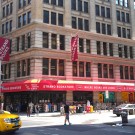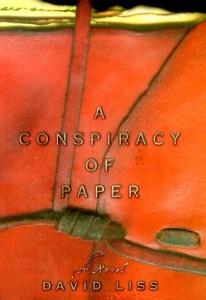A Conspiracy of Paper

“A Conspiracy of Paper” was mystery writer David Liss’s first novel, published in February 2000. It’s a meticulously researched story of a Jewish boxer in 18th century England who gets involved in stock market manipulations that have eerie parallels to what goes on in financial markets today.
I bought the book when it first came out because I like the period and am interested in the stock market. Also, I must confess, I was jealous. I was an active mystery writer at that time, and frankly I wanted to know what kind of book a big-deal publisher like Random House would throw its weight behind. “A Conspiracy of Paper” came out the gate with a bang-up review in the Sunday New York Times and ended with an Edgar for Best First Mystery Novel of the year. And in fact it was a great read. At least I consoled myself with the thought that I  had purchased a first edition (I felt it only right to buy fellow writer’s books, hoping that some of them might follow the golden rule, too), and it would probably be worth something one day. Back then first novels by writers who were hot brought big prices at the many bookstores across America that specialized in mysteries. A mystery writer friend of mine who was practically living out of her car was kicking herself for not having saved a few copies of her first novel which was then selling for almost as much as the advances I received from St. Martins Press.
had purchased a first edition (I felt it only right to buy fellow writer’s books, hoping that some of them might follow the golden rule, too), and it would probably be worth something one day. Back then first novels by writers who were hot brought big prices at the many bookstores across America that specialized in mysteries. A mystery writer friend of mine who was practically living out of her car was kicking herself for not having saved a few copies of her first novel which was then selling for almost as much as the advances I received from St. Martins Press.
Today, sadly, there are few if any mystery bookstores left, and if you want to read “A Conspiracy of Paper” you can for $9.99 download it for your Kindle. But we’re remodeling our small New York apartment and there simply isn’t room for all the books so today was the day that I decided to cash in on my investment.
In terms of dollars, selling your books is orders of magnitude less consequential than selling your stocks or your art, but in certain ways it can offer clearer insight into how markets function. Bookstores and book dealers don’t just make the market for books — they physically OWN the market. Unless you own a bookstore, too, books are virtually unsellable except maybe through Ebay (which for low priced items is more trouble than it’s worth). Luckily in New York City we have the Strand, one of the largest independent bookstores in the world and one that actively purchases books — but strictly on their terms. The Strand is not only prepared but happy to deal with walk-in sellers. Computers allow them to scan the bar code and have instant information about how much they can offer.
Some people might characterize these offers as a conspiracies not of paper, but of spare change. Therein lies the reality of all markets: it is demand that drives prices, not supply. You may have an extremely rare volume, but it doesn’t matter what you think it is “worth.” Yours may be from a tiny edition. The author might be loved by critics and readers alike. You may have seen one in a store for a hundred dollars. None of this matters. The only real question is how many people would buy it if they knew that yours was available for sale? (Perhaps that’s why signed first editions of my mysteries, tiny editions all, linger on Abebooks.com for less than $30.00, but that’s another story.)
If you take your books to the Strand, they won’t even consider anything that isn’t in perfect condition because you probably purchased your books from Barnes and Noble, not Sotheby’s. You don’t have a book collection, you have a lot of used books — and as with used cars or used furniture, a used book has to look pretty good if it’s going to appeal to anybody. The Strand will save you the trouble of shlepping home less than perfect editions — they put them out on the $1 sale tables — but they won’t give you a nickel for a wheelbarrow of them. For books in pristine condition they might pay a few dollars, take it or leave it. Even very nice art books will probably bring less than $10. Again, if you don’t like their offer you can go become a book dealer yourself. Go ahead, try your to sell first edition John Updike on Ebay. According to the Strand, nobody really collects Updike, regardless of how great the New York Times thought his books were — and the press runs were huge so there’s plenty of supply out there. There’s no demand for John Grisham, or most other best-selling authors, either — and the supply is even larger for this stuff. You may point out that booksellers on Abebooks are asking hundreds of dollars for that rare classic the Strand is offering you two bucks for. They will point out that they’ve had six upstairs since 1992, none have ever sold. Why do they need to buy another one at any price?
And those fancy art books? A gallery owner friend of mine bought a few boxes of Chagall catalogues raisonnes when they came out decades ago. Art dealers and appraisers need to buy these essential references so there is a legitimate demand — you can find them one Abebooks for hundreds of dollars. But how many art appraisers are there and how many don’t already have copies? Thirty bucks was all the Strand would offer, and they certainly didn’t want all twenty, the most they might take was one or two. It could take years to sell them and, after all, they already had a few copies.
And David Liss? If you go to Advanced Book Exchange you can find a signed first edition of “A Conspiracy of Paper” in perfect condition for $120. Unfortunately you can also find perfect signed firsts for $10, to say nothing of all the unsigned copies. Publishers support their books to make sales in the primary market, not the secondary one. Random House sent out hundreds of promotional copies, had a national advertising campaign so they could sell enough of that big first printing of Liss’s first novel to make a profit. Everybody thought the author was going somewhere, so plenty of people saved their copies. The Strand already has a ton of them and hasn’t sold one for years. That’s why they didn’t want mine at any price. And I wasn’t going to shlep it home and wait for collecting first mystery novels to come back into fashion.
It will probably be on the $1 table for a long time to come.

